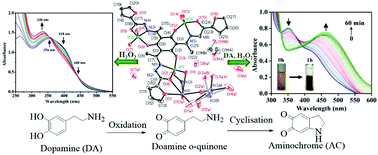Trinuclear vanadium(iv) and vanadium(v) complexes derived from 2,4,6-triacetylphloroglucinol and study of their peroxidase mimicking activity†
Abstract
Novel dibasic Schiff bases with three tridentate sites were obtained from the condensation of the triketone 2,4,6-triacetylphloroglucinol (H3ptk) with four different hydrazides, benzoyl hydrazide (bhz), furoyl hydrazide (fah), isonicotinoyl hydrazide (inh) and nicotinoyl hydrazide (nah): H6ptk(bhz)3I, H6ptk(fah)3II, H6ptk(inh)3III and H6ptk(nah)3IV. These ligand precursors I–IV, each being an ONO donor, are tricompartmental building blocks able to form trinuclear complexes having C3 symmetry. The reaction of I–IV with [VIVO(acac)2] leads to the formation of [{VIVO(H2O)}3(ptk(bhz)3)] 1, [{VIVO(H2O)}3(ptk(fah)3)] 2, [{VIVO(H2O)}3(ptk(inh)3)] 3, and [{VIVO(H2O)}3(ptk(nah)3)] 4. In methanol/aqueous solutions of M2CO3 (M+ = Na+, K+ and Cs+), these complexes are slowly converted into dioxidovanadium(V) compounds, namely, M3[(VVO2)3{ptk(bhz)3}]·6H2O [M+ = K+5, Na+9, Cs+13], M3[(VVO2)3{ptk(fah)3}]·6H2O [M+ = K+6, Na+10, Cs+14], M3[(VVO2)3{ptk(inh)3}]·6H2O [M+ = K+7, Na+11, Cs+15] and M3[(VVO2)3{ptk(nah)3}]·6H2O [M+ = K+8, Na+12, Cs+16]. All ligand precursors and complexes are characterized by various techniques such as FT-IR, UV/Visible, EPR, NMR (1H, 13C and 51V), elemental analysis, thermal studies, cyclic voltammetry (CV) and single-crystal X-ray analysis. X-ray diffraction studies of complexes K2.7[{(VVO2)3ptk(fah)3}]·11.5H2O·MeOH 6a, Cs3[{(VVO2)3ptk(bhz)3}]·7H2O 13a and Cs3[{(VVO2)3ptk(nah)3}]·7.3H2O 16a reveal their distorted square pyramidal geometry by coordinating through phenolate oxygen (of ptk), azomethine nitrogen and enolate oxygen (of hydrazide) atoms. The reactivity of complexes 5–16 and their catalytic potential were screened towards their peroxidase mimetic activity in the oxidation of dopamine to aminochrome driven by H2O2 as an oxidant. The conversion of dopamine to aminochrome with different catalysts was monitored by HPLC showing high activity under mild conditions with good conversions within 1 h. Kinetic studies using compounds 13–16 as catalyst precursors reveal that the reaction follows a Michaelis–Menten-like kinetics.



 Please wait while we load your content...
Please wait while we load your content...